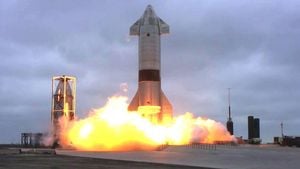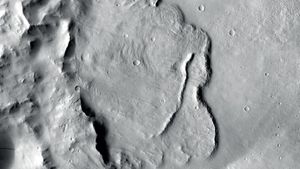This Thanksgiving, skywatchers across the northern United States have reason to be excited as the northern lights, or aurora borealis, may grace the night sky. The National Oceanic and Atmospheric Administration (NOAA) has issued alerts indicating the possibility of these stunning natural displays due to solar storms expected this week.
The forecast outlines potential auroras visible as far south as New England and the Midwest, with prime viewing spots identified across northern states like Washington, Montana, North Dakota, Minnesota, Wisconsin, Michigan, and Maine. Northern areas of Idaho, Wyoming, New York, Vermont, and New Hampshire may be treated to this celestial spectacle as well.
NOAA meteorologist Mike Bettwy shared insights on timing, predicting the best chances to catch the auroras from 10 p.m. EST Thursday to 1 a.m. EST Friday. "These events are usually brief and can vary based on the strength of the solar storms," Bettwy said via email, noting the key to success is clear skies and minimal light pollution.
This year, the sun is currently experiencing its maximum phase of an 11-year solar activity solar maximum, which means solar storms—and by extension, the chance for northern lights—are happening more frequently. Earlier this week, the sun unleashed high-energy plasma, which is traveling toward Earth. The effect of these solar impulses might peak over the Thanksgiving weekend.
A recorded alert from NOAA indicated the geomagnetic storms are expected to exhibit minor (G1) and moderate (G2) activity levels. Such monitors aren't issued lightly; they suggest heightened opportunities for auroral activity right as families gather around their Thanksgiving dinner. The excitement is palpable—not just for the turkey and pie, but also for the chance to see nature's light show.
Yet, it's important to temper expectations. While NOAA alerts indicate visible auroras, the intensity may not produce vibrant hues. Bettwy cautioned, "This isn’t going to be as widespread or as intense as past events this year but will still offer opportunities to see something special for those who are able to escape city lights and look toward dark skies."
Weather conditions will play yet another significant role. For example, northeastern states—particularly Vermont—are expecting snowfall on Thanksgiving Day, with clouds potentially obstructing the view of the auroras. A similar fate could await parts of Wisconsin and Indiana where conditions could be partly cloudy, limiting visibility.
For those located farther south, like Ohio and North Carolina, the light display may depend heavily on weather and storm conditions. While forecasts have been less optimistic, the presence of snow clouds could affect visibility significantly, pushing the ability to see the auroras farther north. Holiday travelers are advised to monitor current weather patterns as they prepare to enjoy Thanksgiving with family and friends.
There’s no specific recipe for predicting when and where the auroras will shine brightest. Still, the best time to catch them is typically around midnight. NOAA urges skywatchers to move away from city lights for optimal viewing and keep their fingers crossed for clear skies.
Finally, for enthusiasts eager to catch this phenomenon, updates will be available via NOAA’s dedicated aurora dashboard, which offers live monitoring and forecasts for northern lights activity. Those wishing to capture the lights on camera should also experiment with long exposure settings, as smartphone cameras can sometimes capture auroral colors not easily seen with the naked eye.
Whether it’s seeking out the northern lights or gathering around Thanksgiving dinner, hope remains high this holiday as astronomy enthusiasts look up, not just at the stars, but also at the flickering beauty of nature's light show above.



